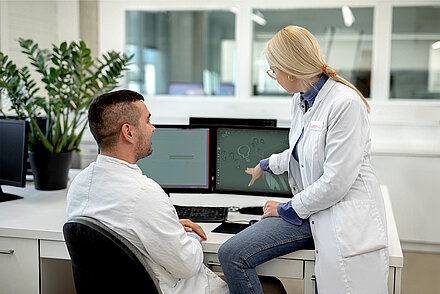The CAD / CAM offers you these advantages in dental technology
CAD/CAM-supported production found its way into dental technology already many years ago. Nevertheless, there are still dentists and laboratories that work analogously.
The CAD/CAM-supported production of dental frameworks offers a number of advantages for your laboratory.
-
Thanks to CAD / CAM, you can benefit from the entire range of materials that the dental industry currently offers.
-
Even difficult materials such as titanium or PEEK plastic can be processed without any problems thanks to the latest
CAD/CAM-technology. -
You can always rely on consistently good quality.
-
Sources of error, such as incorrect casting, are a thing of the past.
-
By saving the data, the structures can also be reproduced at any time.
-
Save resources by adding more value to your laboratory thanks to CAD / CAM
Despite the multitude of advantages, there are still reasons that prevent laboratories from converting analog into digital processes. On the one hand there are the acquisition costs of the equipment, on the other hand there is the concern that the creativity and thus the individuality of the work will be lost. In our view, both concerns are unfounded. Why? We will go into this in more detail below.
CAD / CAM as support for your laboratory
The CAD / CAM production offers support for many process steps in the production of dental frameworks.
From digital impressions at the dentist, through virtual modeling of the frameworks - with the help of CAD (computer aided design) software, to CAM (computer aided manufacturing) supported production using subtractive or additive processes.
"Laboratories do not have to carry out all digital processes themselves and therefore do not have to bear the acquisition costs for the necessary equipment themselves."
After this intermediate step, all further digital processes can be carried out as described above.
You don't have a scanner and therefore no CAD software? Then you have the option of sending your model to us and we will do the construction for you.
"Even virtually you can get creative and give your work your own signature."
Are you worried that you will not be able to give your work your typical handwriting in this way? Then simply send us a wax-up with the model. This pre-modeling is also scanned and provides the basis for the design.
Based on the virtual modeling, stl data are then created. These are transmitted to a CAM software in order to manufacture the framework. There are different procedures for this:
While the choice of materials is still limited in additive processes (precious and non-precious metals in the LaserMelting process, as well as resin in 3D printing), almost all materials can be processed with subtractive processes.
In some cases, also reworking is already possible today with CAD / CAM support - which is usually a little more time-consuming when manufacturing dental frameworks in an additive process than when manufacturing in a subtractive process.
The finalization and characterization then takes place in the conventional way, even if the CAD/CAM-supported production in dental technology has brought some techniques with it due to its diverse materials, which also simplify these work steps.
OUR CONCLUSION
The individuality and creativity in dental technology are by no means lost through digitization and, through a more targeted use of resources, you save time and money thanks to the digitization of your processes. So do not be afraid to take a further step towards digitization, because patients are also more enlightened than ever by using search engines, they find out about their options and insist on care based on the latest findings and technologies.
